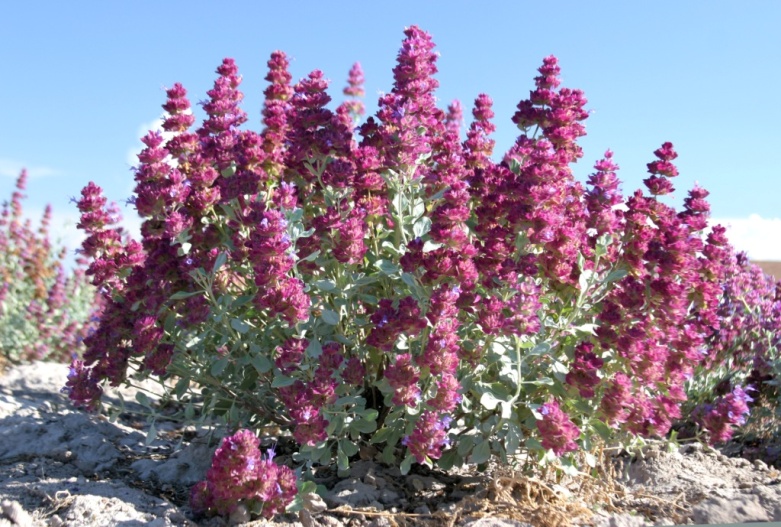Giant Purple Sage in the Landscape

Stephen Love, University of Idaho
Scientfic Name: Salvia pachyphyllaCommon Name: Giant purple sage, rose sage, blue sage, mountain purple sage
Description: Giant purple sage is a long-lived evergreen shrub. It is the big brother of the more common Dorr’s sage. This species combines many nice attributes, including drought tolerance, long bloom period, showy flowers, attractive foliage, and strong aroma. Giant purple sage is valuable for its ability to add late summer color to the water-conserving garden. The plants are woody and highly branched. The evergreen leaves remain attractive through the winter in the warmer climates of the Intermountain West. In colder areas, the leaves and smaller branches may be damaged by cold and require some pruning in spring. Flowers form on new growth and begin blooming in late June or early July. The small flowers are dark blue, set in a background of prolific red-purple bracts. The plants remain colorful well into September. Giant purple sage is one of the most vibrant of all Intermountain West native plants.
Native Habitat: Native range of Salvia pachyphylla includes the southern Sierra Nevada Mountains of California and mountainous areas of southern Nevada and northern Arizona. Common habitats are dry shrublands, rocky slopes, and juniper/pinyon woodlands. This species can be found at elevations ranging from 4,000 to 10,000 feet.
Cultural Requirement
Soil: Well-drained soil is essential for long-term survival of this species. Tolerates clay soils if grown in a dry climate or not over-watered. Adapted to alkaline soils. Shows best form in nutrient-poor soils.
Moisture Tolerance: Capable of growing under completely xeric conditions and will not survive in heavily irrigated sites. Grows well in gardens where limited amounts of supplemental water are applied during the hottest months of the summer.
Sun/Shade/Preference: Full sun.
Transplanting: Easily transplanted as seedlings from flats into pots and from pots into the garden. Plants are easily managed in small pots for a short period of time but require well–drained media and careful watering to remain healthy for an extended period of time. Makes a good subject for one-gallon pots if not overwatered and if over-wintered where the pots do not freeze.
Propagation: Best propagated from seed. Seed lots vary in germination potential and use of a seed lot with known viability is important. Moderate germination rates are obtained without any seed pre-treatments. During seedling grow-out avoid saturation of potting medium and allow soil to dry between irrigations. Seedlings can be teased out of flats and transplanted when they have 2 or 3 true leaves. Raise plants in pots with sufficient depth to allow development of the strong taproot. Giant purple sage is difficult to propagate from cuttings.
Maintenance (pruning, fertilization, deadheading, division, irrigation, etc): Giant purple sage plants require very little maintenance. In cold climates, some pruning will be necessary to remove damaged branches. After bloom, plants require some cleaning to restore tidy appearance. Fertilizer is rarely needed, even in lean soils, and over-fertilization causes the plants to become rank and floppy. Occasional (two to four times during the heat of summer) supplemental irrigation can be applied but is not essential.
Insect, disease, or other problems: Giant purple sage has no known diseases or pests of consequence.
Landscape Value
Use in the Landscape: Giant purple sage is a wonderful plant for a xeric landscape. The shrubby habit and long period of colorful bloom make it a candidate for specimen planting in beds and borders. It can be used very effectively in a formal design but also contributes well to a naturalized garden. This species can be used as a repeated element in a landscape to provide late-season color after other plants are post-bloom.
Foliage: The plants have a low-growing, highly branched, shrubby habit. When mature, plants are about 2 feet tall. The leaves are light silver-green, relatively small, and leathery. Foliage can be dense in mature plants. The leaves are evergreen in warmer climates. The foliage exhibits a strong, minty fragrance, especially if rubbed or crushed.
Flower: Each plant will produce several flower stalks with long panicles of flowers at the tip. The individual small flowers are blue but most of the color comes from the surrounding large, red-purple bracts. Bloom is constant and spectacular for 10 to 14 weeks.
Timing: Late June-September.
Fruit: Fruits take the form of individual seeds; smooth, black nutlets held in a bract structure formed from the residual calyx. Each flower produces a single seed.
Form: Branched and low-spreading.
Texture: Medium-coarse.
Ultimate Size: Mature giant purple sage plants are typically about 2 feet tall and 3 feet wide.
Rate of Growth: Moderate. Plants usually bloom the first summer, grow denser with time and reach mature size in 2 to 3 years.
Suggested Plant Partners: Companions for giant purple sage should be xeric in nature and include some plants with spring bloom. If giant purple sage is to be a specimen plant in the landscape, utilize smaller plants that will keep the summer-blooming plants visible. Good low-growing companions include: Melanpodium leucanthum, Zinnia grandiflora, Penstemon ramaleyi, Oenothera brachycarpa, Antennaria lanata, Eriogonum caespitosum, Calylophus serrulatus, Hymenoxys (Tetraneuris) acaulis, Festuca idahoensis, and Bouteloua gracilis. Cactus species, such as Echinocereus, triglochidiatus, or Opuntia phaecantha can be very effective companions. If used as a complementary element, place giant purple sage around taller xeric plants, such as: Rhus trilobata, Penstemon havardii, Leymus cinereus, Chamaebatiaria millefolium, and Cercocarpus ledifolius.
Availability: Occasionally, potted plants can be purchased from specialty native plant nurseries. Seed can usually be purchased from native plant seed suppliers.
Cultivars: ‘Blue Flame’ and ‘Mulberry Flambe’ are named cultivar’s developed by native plant nurseries but may be difficult to locate.
References:
Nold, R. 2008. High and Dry: Gardening with Cold Hardy Dryland Plants. Timber Press, Portland, Oregon.
Roth, D. 2001. Species account for Salvia pachyphylla ssp. eremopictus. Navajo Natural Heritage Program website: http://www.nndfw.org/nnhp/Plants/sapaer.pdf.

